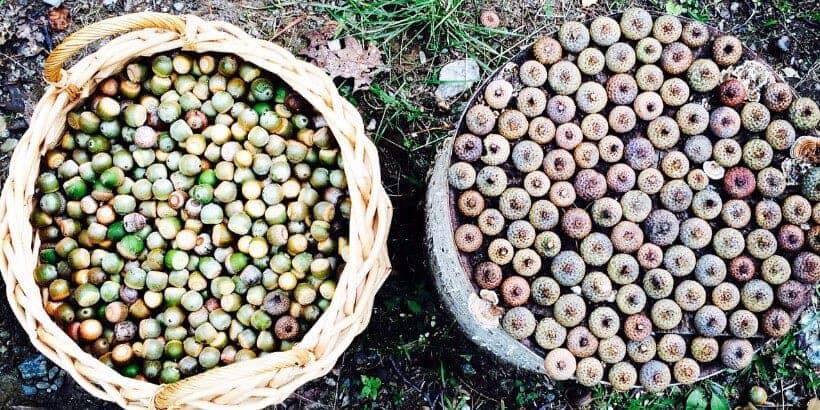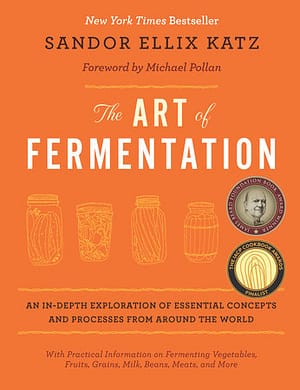Move Over Squirrels, It’s Acorn Harvesting Time!

Think neighborhood squirrels are the only ones who can benefit from the abundance of acorns in the fall? Think again. These small fruits, which are completely edible for humans, are a delicious (and seasonal!) source of nutrients that you can find almost anywhere. Get started on acorn harvesting with help from these simple tips!
The following excerpt is from The Art of Fermentation by Sandor Katz. It has been adapted for the web.
Acorn Harvesting Tips
Acorns, the nuts of oak trees, are edible and in fact have been a critical source of nutrients for many native peoples in North America and elsewhere. In mainstream culture, however, acorns are largely ignored as a food for human consumption.
Meanwhile, ironically, the imminent threat of global food shortages is continually being used to justify deforestation and intensifying biotechnology. I’m not saying anyone should subsist on acorns alone, but let’s tap into the abundant food resources we already have rather than acting based upon the myth of overall scarcity.
The When’s & How’s of Acorn Harvesting

It is not a problem if acorns have already begun to sprout. California acorn enthusiast Suellen Ocean writes:
I like to gather sprouted acorns because the sprouting increases the acorn’s nutritional value. It is no longer in a “starch” stage, but has changed to a “sugar” stage. The sprouting also helps split them from the shell. It is beneficial because if it has sprouted, it’s a good acorn, and I haven’t wasted time gathering wormy ones. I’ve found that an acorn with a two-inch-long sprout is fine, as long as the acorn nut meat hasn’t turned green. I break off the sprout and continue.
Shell, Grind, and Soak
It is important to note that the acorns of many oak trees contain high levels of tannins and require leaching prior to consumption.
To do this, remove acorns from their shells, grind, and soak in water. You can grind acorns dry using a mortar and pestle or mill, or mix acorns with water and grind in a blender or food processor. Acorns should be finely ground to expose lots of surface area, enabling the tannins to leach out.
Leaching After Acorn Harvesting
Acorns can be leached in a fine mesh bag in a running stream (this is the fastest method), or in a series of soaks that can last for a few days. As acorn meal soaks, the meal will settle at the bottom of the vessel and the water will darken.
Gently pour off the dark water at least daily and discard. Water will darken less with each soak, as tannin levels decrease. Keep rinsing with fresh water until it no longer darkens. If you wish to ferment acorn meal, leave it to soak a few more days in just a small amount of water after the tannins have been leached.
 Acorns can be used to fortify and flavor many different foods.
Acorns can be used to fortify and flavor many different foods.
Once I made acorn gnocchi, which were excellent. Julia F. Parker, of the Miwok/Paiute people in California’s Yosemite Valley, wrote a beautiful book about acorn preparation called It Will Live Forever, in which she describes traditional techniques for making a simple porridge (nuppa) using only leached acorn meal and water, which is delicious!
And on a website devoted to the language of another California tribe, the Cahto, I came across reference to “fermented acorn/acorn cheese” (ch’int’aan-noo’ool’).
I have not found further information on fermented acorn cheese, nor have I experimented, but I include this tidbit in the hope that other acorn-loving fermenters will experiment in this vein.
Recommended Reads
Recent Articles
The Garlic Clove! This small crop adds a big punch of flavor that complements almost every delicious dish you could think of. And the best part? These two recipes are a breeze to make together!
Read MoreOur love affair with amaranth began long before the pseudo-grain became a trendy staple for gluten-free folk. The luscious leaves of this annual plant are not only packed with a plethora of health benefits.
Read MoreDon’t know where to start for foraging wild plants? Read on for the information you need to begin foraging on your own: where to do it and how to be safe.
Read MoreEasy rainbow coleslaw! Transform your salad game with this colorful recipe. It is surprisingly packed with flavor and is a great addition to your repertoire.
Read MoreIf you love tomatoes, you probably already know just how many varieties of these summertime staples there are. But do you know what makes each one unique?
Read More








